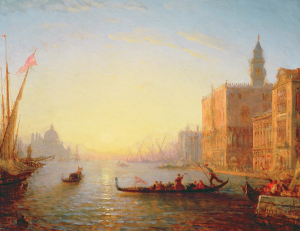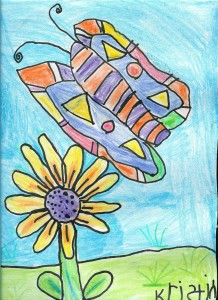ART IN ANY CLASSROOM
ART IN ANY CLASSROOM Attributed to the Taft Museum Art Education Program
Lesson Plans: Upper Elementary
Impressionism & Impasto Painting
In the nineteenth century attitudes about landscape painting changed slowly. Anew cross-disciplinary attention to nature meant that artists began to take an interest in specific sites. Specific locations at specific times of day were made popular by a series of paintings by Claude Monet (French, 1835-1926) of the cathedral at Rouen. Impressionists were able to paint en plein air (outdoors) because of the invention of paint in tubes, which meant that oil paint could be prepared and taken into the countryside.
Most of the landscape paintings in Modern Masters: From Corot to Kandinsky take the motif of specificity one step farther as the artists attempt to capture the momentary. The permanent collection at the Tail Museum of Art also has apainting that utilizes the specificity motif to capture a site at a specific time of day. The Piazza of San Marco, Venice, during a Flood by Felix Ziem captures light as it illuminates the facades of buildings in Saint Mark’s Square. This painting will be used in conjunction with the painting of Notre Dame in the Morning, No. 1, by Francis Picabia to illustrate the importance of color as it is affected by light in the impressionistic style of the painters.
Concept:
Students will study the Impressionist style. Impressionists were concerned with the way color was affected by light and tried to capture images that virtually changed along with the time of day. Most impressionist paintings display visual texture because of the thickness of paint used along with varying brush strokes that allow the viewers’ eye to blend colors as they view the art. Students will select a building in their environment and do three paintings of this building in the morning, afternoon and twilight. Mixing the tempera paint to create an impasto surface will add to the interest of the painting. Color theory along with mixing tints and shades will also be taught in this lesson.
The Art:
Francis Picabia
Notre Dame in the Morning, No. 1, 1906
Oil on canvas, 36 1/2 x 29 in.
It is almost forgotten, because of Picabia’s important work in radical modernism ofthe Dada style, that he had conventional art training and worked for almost six years in the already old-fashioned impressionist style before turning to cubism in 1911. In Notre Dame in the Morning, No. 1, Picabia used the same method as Monet in his celebrated series of Rouen Cathedral, rendering on several canvases the same view at different times as the light changed. This particular painting, first in the series, depicts the famous Paris cathedral and the square in front of it in the early morning when the fa,cade is in shadow.
The Artist:
Francis Picabia (French, 1879-1953) was a wealthy Parisian of Cuban end French descent. He was a painter and the statements he made with his brush had more significance than the words he said or wrote. He married a very wealthy woman named Gabrielle Buffet. Picabia had inexhaustible powers of invention, he was rich, and he was independent, materially and mentally, intellectually end creatively.
In 1913, Picabia and his wife left Europe for America. Alfred Stieglitz became friends with Picabia and displayed his work. When Picabia arrived in New York from Spain, Marcel Duchamp (French, 1887- 1968) was already there. Man Ray (American, 1890-1977) and Duchamp entered into the art circle of Picabia. Picabia, the ultimate artist of the Dada movement, defied life to do its worst and accepted all the consequences. Nothing less but total destruction would satisfy him, at least in the field of art. Even at the height of his battle against art he continued to produce astonishing works of art, whether hairpin portraits, profiles in string, faces made of buttons, or feather landscapes. All these demonstrated his talent even more clearly than his contempt for art. Somewhere in the depths of Picabia’s soul, he hoped to find a meaning “behind it all.”
The Art: Felix Ziem
The Piazza of San Marco, Venice, during a Flood, late 1850s
Oil on canvas, 37 5/8 x 27 1/4 in.
Ziem was the first important French artist to adapt the tradition of painting Venetian views as pioneered by Canaletto (Venetian, 1697-1768) and Francesco Guardi (Venetian, 1712-93) during the eighteenth century and furthered by J. M. W. Turner (English, 1775-1851) in the first half of the nineteenth century. Later, other members of the French school would follow his path, notably Pierre-Auguste Renoir (French, 1841 – 1919) and Monet. Ziem’s Venetian cityscapes approach the effects of impressionism in their emphasis on the depiction of natural light and atmosphere, and painterlybrushstrokes. The color is high-keyed. Ziem chooses picturesque views that emphasize the scenic rather than the crumbling aspect or the political reality of the city. This tourist landmark was the focus of Ziem’s Venetian works, which were greatly sought after by collectors during the nineteenth century.
The Artist: Felix-Francois-Georges-Philibert Ziem (French, 1821-1911)
Felix Ziem’s family settled in Dijon, France where he studied linear design and classical architecture at the school there from 1837 to 1839. In May 1842, Ziem left Nice for a Grand Tour across Europe. On his second visit to Venice, he said that he found it “a port of life”. He revisited the city eighteen times throughout his career. In 1844-45, Ziem actually lived on a houseboat in Venice.
Many critics feel that the early work of Ziem was his most inventive and fruitful. His later work became repetitious and commercialized. Ziem won medals in the Salon of Paris for his Venetian and marine subjects. He was praised by the Goncourts and other critics. Ziem became increasingly popular during the 1860s, although writers began to criticize the lack of “drawing” or definition in his works, a nonacademic finish for which the impressionists were also rebuked. He exhibited his last works in the Salon in 1888 and then began to sell his paintings through Parisian dealers.
In 1877 Ziem built a villa near Nice. His last trip to Venice was in 1897. He married his longtime companion from Provence in 1904 and attained a position of Commander of the Legion of Honor in 1908. Ziem died on November 10,1911.
Impressionism:
The Impressionists challenged academic traditions in French painting in the 1870s and 1880s, particularly. The major artists to whom the label “Impressionists” came to be attached were all born within eleven years of each other between 1830 and 1841. All of them studied in Paris, many at the same art school. They shared the same preoccupations and the same immediate past. Most of them were also from the bourgeoisie, whether great or small, and therefore born into the class which was to dominate French artistic taste for the better part of the nineteenth century. Impressionism had tremendous, widespread influence because of its technical innovations as well as its desire to depict reality through capturing ever-changing aspects of light as the phenomenon that makes vision possible. Monet was the classic practitioner of this style, which is characterized by beautiful, strong colors, broad visible brushstrokes, outdoor subjects, including people and leisure, and a light, airy appearance.
Technological advances as a result of the Industrial Revolution played a central role in the impressionist achievement by giving the movement’s artists the ability to develop their own painting techniques and take advantage of the new colors. The three significant developments were the introduction of mechanical grinding, oil binders, and additives to keep paint fluid and workable in the new tube containers. All these combined to influence the texture of the mid-nineteenth century paints, which were more suitable to impasto (heavily builtup, highly textured) work.
The use of the term “impressionism” in connection with Monet’s work gives some indication of the manner in which the painting was conceived. As an expression, “impressionism” was already current in discussions on mid-nineteenth century French painting; it denoted the initial effect imposed on an artist’s mind by a given subject. John House, however, has observed that Monet meant it to signify not the initial idea set off by a painter’s reaction to a scene, but rather that idea in physical form made in paint on canvas.
In the series of paintings by Monet of Rouen Cathedral the understanding of impressionism is an unchanging and unchangeable object, yet one that provokes a constant movement of light in the most complex way. At every moment of every day, the changing light creates a new view of the cathedral, which seems as though it were constantly altering. In front of Monet’s twenty views of the building, one begins to realize that art, in setting out to express nature with ever growing accuracy, teaches us to look, to perceive, to feel.
The Lesson:
National Goals and Standards:
- Students create artworks that use organizational principles and functions to solve specific visual arts problems.
- Students intentionally take advantage of the qualities and characteristics of art media, techniques, and processes to enhance communication of their experiences and ideas.
- Students generalize about the effects of visual structures and functions and reflect upon these effects in their own work.
- Students know that the visual arts have a history and specific relationships to various cultures.
Vocabulary:
Binder – Sticky oil or glue used in paints to bind pigments together. As the binder dries and hardens it holds the pigment to the surface of the painting. Binders maybe made of vegetable oils, egg yolks, petroleum, beeswax, glue or gum arable.
Brush – The finest brushes used for watercolor are made of sable hair. Stiffer brushes are made from pig hair or boar bristles. Brushes come in all shapes and sizes allowing the artist to make different kinds of brush strokes.
Canvas – A strong woven cloth used for painting. It was traditionally made of hemp or linen. Today, it is mostly made of cotton or artificial fibers. Canvas is usually stretched over a wooden frame and covered with a ground such as gesso, before it can be painted. This stops the canvas from soaking up too much paint.
Easel – An easel holds a canvas steady while a painter works on it. Easels come in all sizes and shapes. Lighter easels can be folded and used outdoors.
Oil paint – Oil paint is made by mixing pigments with vegetable oil (usually linseed oil) into a thick paste. To make the paint thinner, the artist mixes in more linseed oil or varnish or turpentine. Oil paint dries very slowly so that the artist has time to blend in the brush strokes.
Palette – In the 1400s, painters began to layout and blend colors on a slab of wood, stone, or ivory. This slab came to be called a palette. In the 1800s palettes were large and kidney shaped. A hole was also made in them for the artist’s thumb.
Pigment – A colored powder taken from a plant, animal or mineral (such as a rock). To make paint, the pigment is mixed with water, oil, wax, or egg—to bind it. Today most pigments are made with chemicals and the range of colors is quite large.
Tempera – Tempera is made with a binder of egg yolk. Tempera dries quickly and brush strokes do not blend easily. The artist must blend color by painting colors on top of one another.
Motivation:
Decorate the classroom with many reproductions of impressionist paintings. Talk about the style of painting with your students. Travel to the Taft or the Cincinnati Art Museum to view actual impressionist paintings. Study the school building or other buildings in your area for differences in color depending on the time of day or light source. Students may do this activity at home on the weekend with a side of their house.
Studio Procedure:
1 . Students use three pieces of matt board or cardboard to make a quick sketch of the building they will paint. Make sure all drawings are about the same size.
- Mix impasto tempera paint using one tablespoon of white detergent powder. Stir until mixed. **NOTE: Other thickeners that work well are powdered cornstarch, or white flour, using the same 1 T. to l/2 cup paint. Tempera paint thicknesses can vary also, so be prepared to thin with water or thicken with more thickeners!
Materials:
• Jars or cups for mixing paint
• Spoons
• Flat containers or grocery polysterene trays
• Craft sticks
• Paintbrushes (variety of sizes)
3. Scoop paint onto the plastic trays to form a palette.
4. Apply paint to the buildings that have been sketched. Each building should be painted in the morning light, afternoon light, and dusk or nighttime.
5. Mix colors together to make tints (white) and shades (black) or new colors.
6. By using paint brushes and craft sticks, the painting will take on an Impressionist feel because of the thick paint. Remember any mistakes can be painted over!
7. Allow the thick impasto paintings to dry overnight.
8. The next period, discuss the results of the time/color study and the buildings. Display the work as a series.
(Assessment Tool is on a separate page.)
Critical Questions:
- Identify the hues in the paintings by Picabia and Ziem. How do the colors tell you what time of day you are looking at?
- Does the handling of light on three dimensional forms enhance them or dissolve them? Do the buildings look hard-edged or softened?
- Do these paintings appear to have movement or are they static? What makes them move?
- What are the dominant hues in each painting? How do the artists keep these hues from dominating the entire canvas?
- Point to several examples of varying degrees of color value and color intensity in each painting
Curricular Connections:
Language Arts: The paintings by Picabia and Ziem are of very famous places and tourist attractions. Make a postcard of a famous place you have visited and write about your experience on the back. Share the postcards with your class.
Math: Measurement is used in both mixing paint with the thickeners and the measurement of the buildings with a ruler in all of the paintings. Geometric shapes are also used.
Social Studies: Study the history and architectural style of the buildings in each painting. Locate each site on a map. What was happening in the world during the time of impressionism?
Science: Study the science of vision and the eye. How do we see? What other technological advances have made a profound impact on the world and society? How does a camera work?
Music: Listen to the music of Wagner. He was a popular composer that many of the impressionists liked to listen to. The opera was also very popular with the impressionists. Degas loved the ballet. Try to visit the Cincinnati Opera or Ballet
Bibliography:
Adams, Steven, The Impressionists, London: 2000.
Amiel, Leon, The Impressionists, New York: 1985.
Hunter, Sam and John Jacobus, Modern Art, New York: 1985.
Kachur, Lewis C., “Nineteenth-Century French Paintings,” The Taft Museum: European and American Painting, NewYork: 1995.
Kohl, Maryann F. and Kim Solga, Discovering Great Artists, Bright Ring Publications: 1990.
Massey, Sue J. and Diane Darst, Learning To Look: A Complete Art History and Appreciation Program for Grades K-8/Book and Slides, 1992. (out of print)
Richter, Hans, Dada Art and Anti-Art, New York: 1965.
Yenawine, Phillip, How To Look At Modern Art, New York: 1991.
Cityscape Painting Assessment
Impressionism Impasto
1. Composition Low High
- Buildings are balanced on page. 1 2 3 4
- Buildings are erect. 1 2 3 4
- Foreground, middleground, background evident 1 2 3 4
2. Details
- Detail of buildings is clear 1 2 3 4
- An awareness of paint texture is demonstrated 1 2 3 4
- Awareness of paint texture is demonstrated 1 2 3 4
1. Color
- Tints and Shades are mixed 1 2 3 4
- New colors are made 1 2 3 4
- Colors indicate time of day 1 2 3 4
1. Light Source
- The effect of source of light is indicated by the use of headlight 1 2 3 4
- Cast shadows are evident 1 2 3 4
1. Neatness
- Demonstrates skill in handling paint medium 1 2 3 4
- Cardboard is not smudged or bent 1 2 3 4
- Clean-up of brushes, trays and table evident 1 2 3 4









Leave a Reply
Want to join the discussion?Feel free to contribute!